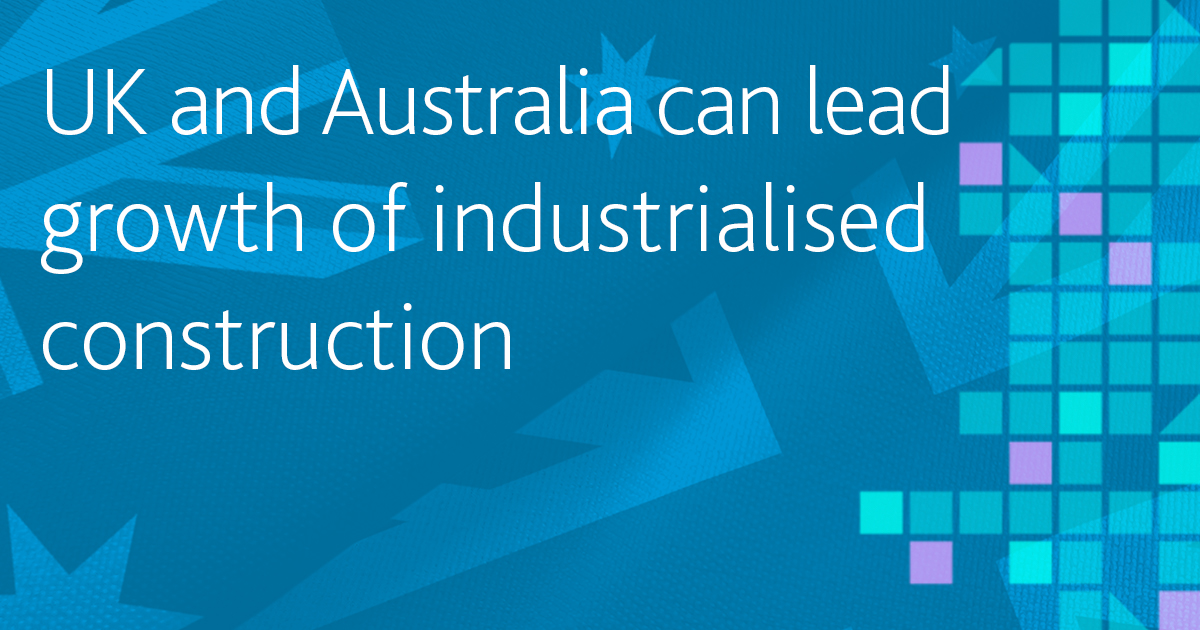Out-Law Analysis 8 min. read
UK and Australia can lead growth of industrialised construction

03 Feb 2022, 2:30 pm
The UK and Australia can be leaders of growth in industrialised construction over this decade if clear policy can be backed up with business incentives and a pipeline of work.
The UK is already a global leader in industrialised construction, boasting an advanced policy framework that provides the basis for growth in the future. However, it can learn much from both Singapore and Hong Kong in how they have developed a clear pipeline of projects and incentives to support market take up.
For Australia, the huge potential to support the industrialisation of construction processes is currently being stifled by insufficient and inconsistent government intervention.
According to Oxford Economics Singapore’s construction market will grow the fastest of these four countries. Over the next 15 years it will grow at 2.9% a year between 2021 and 2036 to reach US$28.9 billion. Hong Kong’s will grow by less than 1% a year to reach US$30.6bn by 2036 and will be the slowest growing of the four markets.
Both Australia and the UK are much larger construction markets. The overall construction market in Australia is expected to grow to reach over US$171bn by 2036 whereas the UK is expected to grow slightly faster than Australia to reach almost US$265bn by 2036.
The size and scale of construction markets in both Australia and the UK, coupled with a shortage of skilled labour, helps mark these two countries out as highly attractive for growth in industrialised construction.
What is industrialised construction?
At the heart of industrialised construction is the greater use of data and digital technology to understand and measure the performance of infrastructure and other built assets, and to support greater standardisation of the way components are made and of design and construction processes.
It also encompasses everything from a shift towards the commoditisation of construction products through new manufacturing processes aimed at reducing defects and achieving efficiencies, to a fully integrated supply chain working collaboratively under contractual models that underpin that, and envisages seamless integration of health and safety processes, quality control procedures and digital payment systems into construction operations.
A growing global market
Given the potential of industrialised construction to provide efficiencies, bolster productivity and drive decarbonisation in the sector, it is little surprise that the market is tipped to grow.
According to a report published by Allied Market Research in August 2021, the global offsite construction market generated $130.4 billion in 2020 and revenues are projected to reach $235.46 billion by 2030. Growth over the period is expected to be driven by factors such as a rapid rise in urbanisation and industrialisation, an increase in the pace of construction, and high efficiency of offsite construction in developing countries.
Housebuilding, which already accounts for around 60% of the global offsite construction market, will continue to be at the heart of growth in offsite construction, according to the report, though the compound annual growth rate (CAGR) is expected to be highest in the commercial sub-sector over the decade.
A 2019 report by McKinsey highlighted the potential for real estate companies to make a 20% savings on construction costs by embracing modular construction. It said that the market value for modular in new real estate construction alone could reach $130bn in Europe and the US by 2030, delivering annual cost savings of $22bn.
A Savills report from May 2020 further predicted that the proportion of housing built in the UK using modern methods of construction will rise from around 10% today to closer to 20% by 2030.
Policy direction in the UK
Increasing policy guidance, which stands to support growth of industrialised construction, marks the UK out as a global leader in the movement, alongside the much smaller construction markets of Singapore and Hong Kong.
The UK government has said it is “committed to using its position as the single largest construction client to support adoption of a more productive, efficient and sustainable business model within the UK construction sector” and that such innovation is vital to its aims of achieving a net zero emissions economy by 2050.
Government support for the industrialisation of construction processes in the UK has been evident for a number of years and is beginning to gain traction in the industry.
Notable interventions include the presumption in favour of offsite construction that has been adopted for certain department-backed projects and the plans to improve the performance and delivery of infrastructure assets set out in the ‘Transforming Infrastructure Performance’ (43-page / 1.07MB PDF) policy paper.
Plans to leverage “the government’s collective buying power to aggregate demand for platforms made up of digitally designed components, that can be used across different built assets” via what it called “a platform approach to design for manufacture and assembly” (P-DfMA) were also set out in a call for evidence in November 2018. In its response to that evidence-gathering exercise in December 2020 it further noted the importance of a “strong, committed and visible” pipeline of projects to help industry in developing the new approach.
Further support for the new ways of working in the construction industry were outlined in the Construction Playbook, published in December 2020. The playbook is effectively a best practice guide to project procurement and delivery, and includes a series of policies including one that recognises the need for harmonised, digitised and rationalised demand where a platform approach and modern methods of construction can be used.
The Infrastructure and Project Authority’s paper, ‘Transforming Infrastructure Performance: Roadmap to 2030’, published alongside the National Infrastructure and Construction Pipeline in August 2021, also set out the long term vision for a platform approach to construction. The pipeline identifies 170 contracts currently in procurement, totalling an estimated capital value of up to £22.4bn, where elements can be delivered using Modern Methods of Construction
The government’s endorsement of a review’s recommendation to overhaul construction frameworks also signals its intention to boost understanding and adoption of digital technologies and Modern Methods of Construction.
However, despite the strategic direction and clear policy intent, and recognition that a pipeline of work needs to be provided to support industry’s investment in change, harmonisation of the pipeline remains some way off and as a result the sector is still gearing up.
Pipelines and incentives: lessons to learn from Singapore and Hong Kong
Though significant smaller construction markets, Singapore and Hong Kong have developed strong project pipelines to support the shift to industrialised construction in industry, backing up clear policy direction that has been articulated in the two cities.
In Singapore, the Design for Manufacture and Assembly (DfMA) model was identified as critical to improve productivity in the construction industry and has been a priority for the Singapore government since 2011. Initiatives include the 2014 mandate that all government housing projects must use prefinished volumetric modules.
Recent figures indicate that construction productivity in Singapore has seen a 7% improvement since 2017 thanks to DfMA and digital technologies. Government data suggest DfMA adoption more than doubled from 19% in 2017 to 39% in 2020. We are aware of 85 upcoming public and private projects prescribing DfMA, including 10 valued at over S$300m ($222.7m) each.
In Hong Kong, the 2018 government publication ‘Construction 2.0’ identified three strategic thrusts, including DfMA, BIM, and design for buildability, to transform the Hong Kong construction industry. Over HK$1 billion ($130m) was allocated for the establishment of a Construction Innovation and Technology Fund (CITF) to provide impetus. There are now about 60 modular integrated construction (MiC) projects in the pipeline in Hong Kong, a notable increase from a handful of projects when the CITF was launched.
The experiences in Singapore and Hong Kong shows what is possible with the right intervention in the UK. The pipeline issue appears to be well-recognised in the UK, and it is welcome in this regard that the Crown Commercial Service is looking to tender a £10bn framework agreement for offsite solutions. A full contract notice is expected to be published on 1 July 2022.
To further encourage industry’s shift to offsite construction and adoption of other modern methods of construction, the UK government should consider what financial incentives it can offer the sector. Inspiration can be taken from the use of contracts for difference in the offshore wind sector almost a decade ago, which helped support industry’s investment in the technology at a time when the capital costs and risks were otherwise commercially unviable. Today, the offshore wind industry is thriving without subsidies and has become an integral part of the UK’s energy mix.
Australia and other potential growth markets
Australia is another sizeable construction market where the full potential of industrialised construction has still to be realised. According to Savills’ May 2020 report, less than 5% of homes built per year have been built using modern methods of construction.
Adoption of DfMA in Australia has, more generally, been slow too. An August 2021 paper found that one of several reasons for this has been that the Australian government has not provided adequate attention, incentives, or suitable regulations to support the adoption of DfMA.
However, the potential for growth in the market was recognised in a 2019 report, which forecast that the prefabricated building market would grow from just 3% of the A$150bn ($109bn) construction industry in the country to 15% by 2025, creating 20,000 jobs and adding A$30bn ($21.8bn) to the country’s economy in the process.
A positive development in the market was the establishment of the Building 4.0 CRC (Co-Operative Research Centre), an initiative set up in 2020 and co-funded by the Australian government that aims to help develop an advanced manufacturing sector, delivering better buildings at lower cost. Amongst its goals is improved and safer construction assembly through “DfMA processes and smart engagement with changing construction sites”.
One view from the August 2021 paper, however, was that “government drivers and commitments are essential to transition to offsite construction” in Australia and that “a committed pipeline needs to be created by state governments for the industry before it rolls into procurement”. To-date, however, there has been insufficient intervention by government bodies in Australia to support the transition.
In addition, some incongruities between the federal government and state governments make establishing new regulations and providing incentives more complicated. The Australian planning codes give less consideration to modularised type construction, and the building codes are geared more towards bespoke construction rather than standardised modular construction.
These are features of the policy and regulatory environment that need to change for industry in Australia to embrace industrialised construction and realise the associated benefits.
Other growth markets for industrialised construction are likely to emerge this decade too.
The UAE’s plans for Dubai to become a global hub for 3D printing, and its stated target of constructing 25% of buildings in the emirate by 3D printing by 2030 – from 2% in 2019 – makes it a potential growth market for industrialised construction over this decade too.
However, while a February 2018 report on the UAE by MEED and Mashreq (20-page / 972KB PDF) found that “offsite prefabrication is growing and modularisation through design for manufacture and assembly is taking off as the undeniable time and cost savings are recognised in projects around the region”, it also recognised that “conservative approaches to construction methods by authorities and regulators in the UAE hinder the adoption of prefabricated components such as large precast structural elements”.
As that report highlighted, it is vital that construction industry transformation is supported by government agencies. The report flagged that “approval and permitting processes frequently do not match the national vision [of diversifying the economy to reduce the reliance on oil exports] and slow the adoption of innovative practice”.

